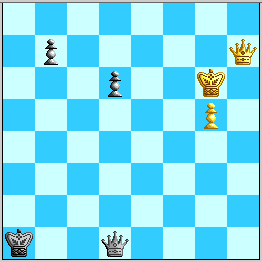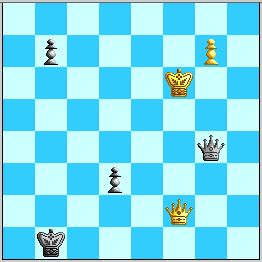
Diagram 1, White to move. The easiest draw for Black.

Diagram 1, White to move. The easiest draw for Black.
Black steps away from the discovered check, and White must move his Queen. Players may have feared 52. Qxb7 (hence the votes for 51...b5?!), but 52...Qc2+, 52...Qd3+, 52...Qd4, 52...Qg4, and 52...d5! (strategically the best reply) all draw. For example,
A) 52.Qxb7 d5 53.Kf7 (53.Kh6 Qd2! 54.Kg6 d4 55.Kf5 Qf2+ is equal) 53...d4 54.g6 d3 55.g7 Qf1+ 56.Ke8 Qe2+ 57.Kf8 d2, leads to a draw.
The most important variations follow the sequence:
B) 52.Qg7+ Ka2 53.Qf7+ d5 (53...Ka3 appears to make the 54. Kg7! idea effective---more analysis is needed), and now three important lines:
B1) 54.Qf2+ Kb1 55.Kf6 d4 56.g6 d3 57.g7! Qg4! (an important move which covers not only the g8-square, but also the c8-square. This defense was found by SmartChess Online analysts and further refined by Regan, Richard Maisiak as "Spy49", and other WT analysts)

Diagram 2, White to move. Delicate but not too dangerous for Black.
58.Qb6+ Kc1, and now:
B11) 59.Qc5+!? Kb1! 60.Qd5 Qf4+ 61.Ke6 Qg4+ 62.Kf7 Qf4+ 63.Ke8 Qa4+! maintains equal chances.
B12) 59.Qc7+ Kb1 60.Qxb7+ Kc2 61.Qc7+ Kd1 (but not 61...Kb2?? 62.Qb8+, and White wins) 62.Qf7 Qf4+, and Black is OK, for example: 63.Kg6 Qg3+! (Regan's move, which looks better than the 63…Qe4+ that had been explored by SmartChess Online) 64.Kf5 64...Qf2+ 65.Ke6 Qa2+ 66.Ke7 Qa7+ 67.Kf8 Qa8+ 68.Qe8 Qf3+, with equal chances.
This line B12) is fairly delicate---we knew that on 61. Qc6+, Black must play 61...Kb1/b2!, as 61...Kd1 leads to a White win with 62. Qd5! The EGTB server started at 60. Qxb7+ backs this up, showing that 62. Qd5 is the only move to win and ckeckmates in 42 more moves. However, World Team analysis removed all terror from this line, and from other tries by White between 54. Qf2+ and 60. Qxb7+.
B2) 54.Kg7 is met by 54…Qd4+! for example: 55.Qf6 (best try) 55...Qe3 (55…Qe4 or 55…Qc4 also seem playable) 56.g6 d4 57.Kf7 (57.Kf8 d3 58.g7 Qc5+! is equal) 57...d3 58.g7 d2 59.g8=Q Qb3+ 60.Kf8 Qxg8+ 61.Kxg8 d1=Q 62.Qf2+, with a draw.
During the actual game, we believed that 54. Kh7 was White's most dangerous try, and since 54...b5 55. Qf2+ K-moves 56. g6 looks difficult for Black, that 54...Qc2+ 55. g6 b5 was necessary. Now 56. Kh6 leads to dangerous play---in order to prevent White from penetrating on the Queenside, Black must organize an "e-file block" by 56...Qh2+ (or 56...Qd2+ 57. Kh5 Qe2+) 57. Kg5 Qe5+. White has some dangerous tries here, however. One is to try to penetrate the King by 58. Kg4 Qe4+ 59. Kg3 Qd3+! (Black keeps an eye on White's pawn to prevent interpositions that would set up the "Cannon" theme) 60. Kg2 Qe4+ 61. Kf2 Qc2+ 62. Ke3 Qe4+! (else White penetrates) 63. Kd2 Qd4+ and White is stopped. More dangerous is 58. Qf5, when our original idea 58...Qe7+ 59. Qf6 Qe3+ 60. Qf4 Qg1+? 61. Kf6 b4 loses as 62. Qxb4 is EGTB+/-, mate in 77 more moves (transposing into lines that could have been reached in the actual game from 58...Qf5). Black can, however, defend simply by 60...Qe7+ 61. Kg4 b4!
However, all this is mooted by the (later by KWR---did B.McC have it?) discovery that 54...Qh1+! is a bang-bang draw:

Diagram 3: Black's b-pawn is faster!
B3) 54. Kh7 Qh1+! 55. Kg8 (there does not seem to be much independent point in 55. Kg7) b5! and now:
If any WT member saw 54...Qh1+ out to a draw, please let us know---it seems not to have been in any SCO FAQ. This certainly is a short demonstration of a clean draw, compared to anything else in the analysis of this ending!